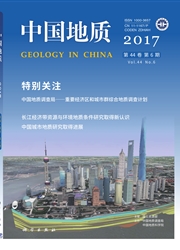

 中文摘要:
中文摘要:
魏家钨矿床位于湘南西部铜山岭地区,是近年来在南岭成矿带西端新发现的一超大型矽卡岩型钨矿床。矿体主要产于祥林铺花岗岩与其围岩的接触带内,其形成与祥林铺花岗岩密切相关。为厘清其成岩成矿时代,本文对魏家钨矿区的花岗斑岩和石英斑岩进行了锆石LA-MC-ICP-MS U-Pb测年。结果显示,矿区花岗斑岩侵位时间为(157.8±0.9)Ma(MSWD=1.06),石英斑岩侵位时间为(158.3±1.4)Ma(MSWD=0.2)。矿区内花岗斑岩与石英斑岩侵位时间在误差范围内一致,表明两者可能是同一岩浆演化至不同阶段的产物,矿区内花岗质岩浆活动与钨多金属成矿作用时限约为158 Ma,为南岭地区中生代"大规模成矿"作用(160-150 Ma)的组成部分。另外,花岗斑岩中捕获有少量加里东期的岩浆锆石(435 Ma),指示该区曾发生加里东期岩浆活动,这与华南地区广泛存在的加里东期构造岩浆活动事件吻合。魏家钨矿成岩成矿时代的厘定对于在南岭成矿带西端寻找晚侏罗世钨矿具有重要的指示意义。
 英文摘要:
英文摘要:
The Weijia tungsten deposit, located in the Tongshanling area of western Nanling metallogenic belt, is a newly discovered giant skarn tungsten deposit, with its orebodies mainly occurring at the contact zone between the Xianglinpu granite and Devonian carbonate rock. To determine the timing of the emplacement of the Xianglinpu granite and associated mineralization, the authors collected two kinds of granite, i.e., granite porphyry and quartz porphyry, from the Xianglingpu pluton for zircon LA-MC-ICP-MS U-Pb dating. The results show that the zircon U-Pb ages of granite porphyry and quartz porphyry are(157.8 ± 0.9) Ma(MSWD=1.06) and(158.3 ± 1.4) Ma(MSWD=0.2), respectively, suggesting that their emplacements were coeval within error and they were derived from the same magma source. In addition, the captured zircons from granite porphyry yielded the weighed mean U-Pb age of(435.0 ± 3.1) Ma(MSWD=0.6), which recorded the Caledonian tectonic- magmatic event in this area. Based on the contact relationship between skarn tungsten orebodies and granite, the authors hold that the emplacement of Xianglinpu granite and associated tungsten mineralization occurred at ca.158 Ma, which coincided well with the large-scale mineralization of the Nanling in Middle-Late Jurassic(150-160) Ma. The constraint of the Late Jurassic Weijia skarn-type tungsten deposit implies the great potential of the late Jurassic skarn-type tungsten mineralization in western Nanling W-Sn metallogenic belt.
 同期刊论文项目
同期刊论文项目
 同项目期刊论文
同项目期刊论文
 Zircon U-Pb ages and Hf isotopes of the granitoids in the Huangshaping mining area and their geologi
Zircon U-Pb ages and Hf isotopes of the granitoids in the Huangshaping mining area and their geologi Disproportionation and thermochemical sulfate reduction reactions in S–H2O–CH4 and S–D2O–CH4 systems
Disproportionation and thermochemical sulfate reduction reactions in S–H2O–CH4 and S–D2O–CH4 systems In situ LA-ICP-MS REE analyses of the skarn garnets from the Jinchuantang tin-bismuth deposit in Hun
In situ LA-ICP-MS REE analyses of the skarn garnets from the Jinchuantang tin-bismuth deposit in Hun A Late Cretaceous tin metallogenic event in Nanling W-Sn metallogenic province: Constraints from U-P
A Late Cretaceous tin metallogenic event in Nanling W-Sn metallogenic province: Constraints from U-P Re-Os dating of molybdenite from the Xintianling giant tungsten-molybdenum deposit in southern Hunan
Re-Os dating of molybdenite from the Xintianling giant tungsten-molybdenum deposit in southern Hunan 期刊信息
期刊信息
